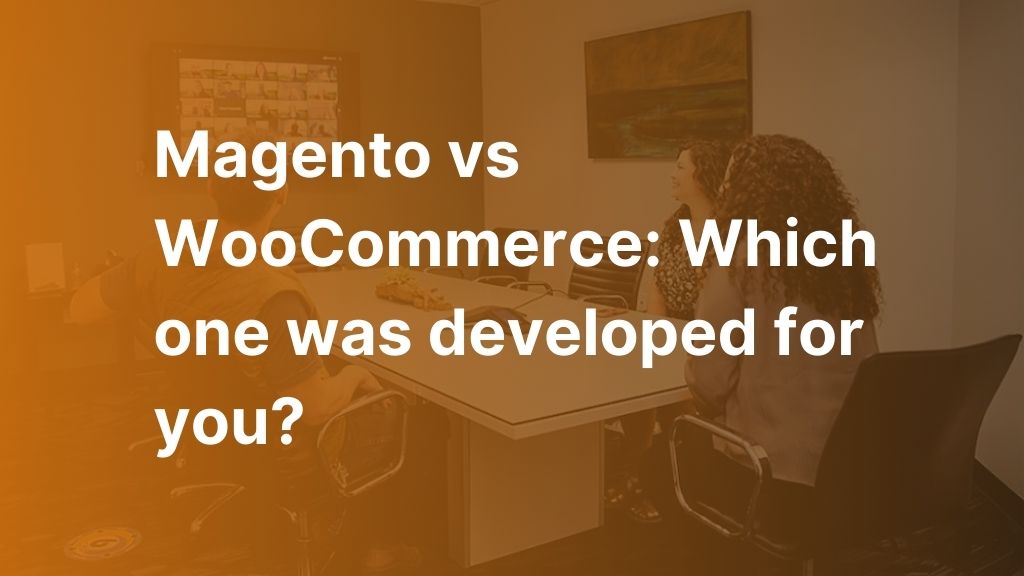An eCommerce platform is like the foundation to build your house on. That’s why choosing the right platform is crucial for online businesses to thrive. Among many eCommerce platforms on the market, Magento vs WooCommerce are two popular solutions worth considering.
So in this article, we will walk you through the differences and strengths of WooCommerce vs Magento 2 to help you make an informed decision about which is better for you. Let’s go!
Magento and WooCommerce: A Brief Overview
Table of Contents
About Magento

For beginners, this is the answer to “What is Magento platform?” The Magento eCommerce platform, first introduced by Varien in 2007, is an open-source framework famous for its high customization and scalability. Since its inception, Magento has steadily risen in popularity, offering a wide array of products and versions. Currently, more than 250,000 eCommerce websites utilize Magento, underscoring its widespread adoption and success.
Magento offers 2 editions, which have been explained in our article Magento Open Source vs Commerce. Besides, Magento Commerce Cloud (Magento ECE) is the most premium edition with additional features that differentiate it from Magento Open Source and Magento Commerce.
Key Features and Functionalities
Magento has a free community feature-rich version that is not commonly available on other platforms. It enables store owners to set up multi-language, and multi-currency for multiple stores or store views Since it is open-source, you can customize and develop the functionality you need by coding.
The paid version – Magento Commerce provides a lot of exclusive features, including:
- Category permissions
- Gift cards
- Advanced catalog search
- Customer segmentation
- Email reminder
- Reward & Loyalty
- Store Credit
Additionally, you can learn more about the Magento 2 B2B features to start empowering your B2B business.
About WooCommerce
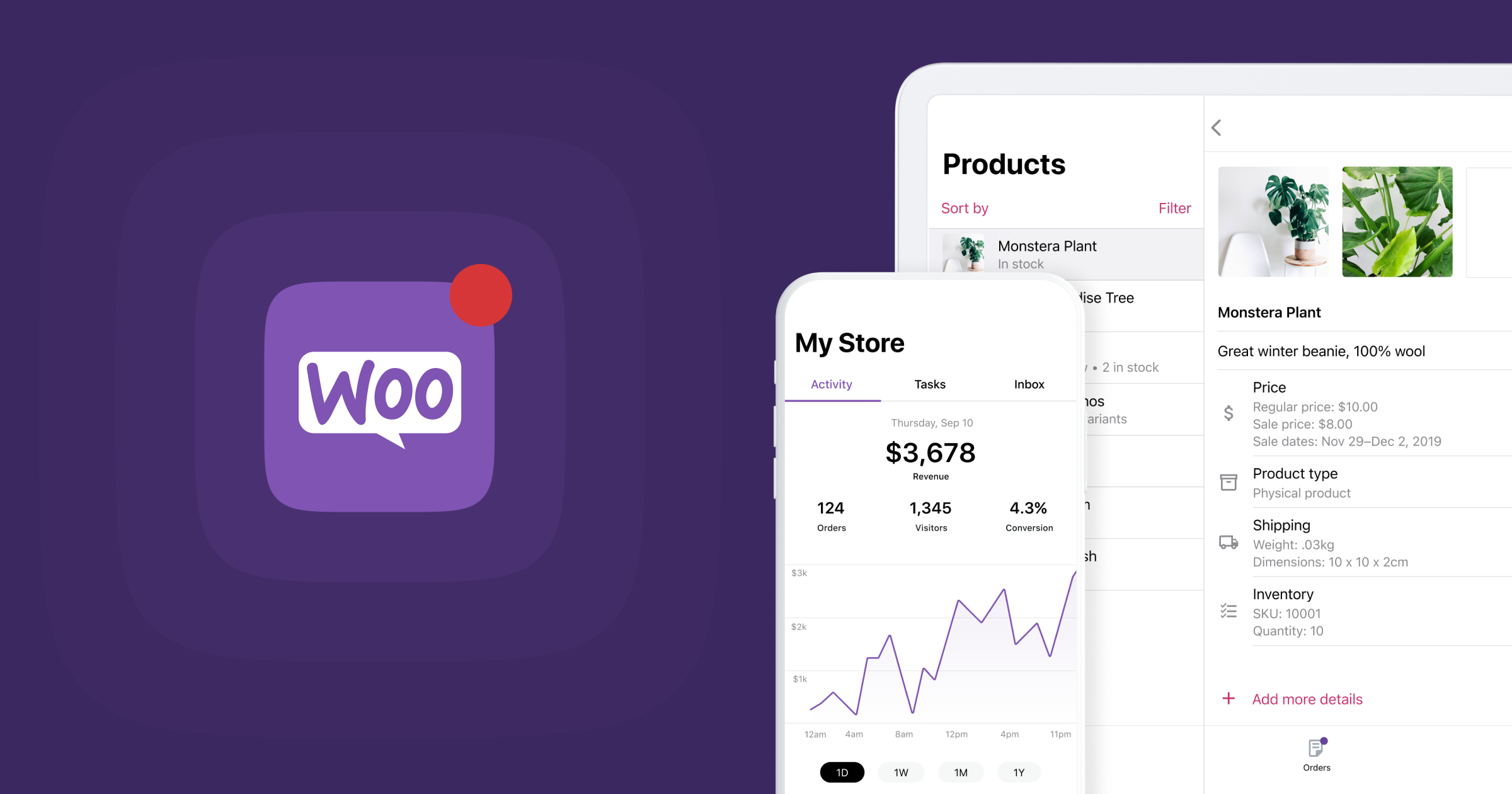
WooCommerce is a plugin that can change a WordPress-based website into an online store. First known in 2011, but so far, WooCommerce has powered over 28% of all online stores according to stats. This portion is not a surprise since WordPress occupies about 50% of the CMS market share over the globe.
Key features and functionalities
WooCommerce provides seamless integration with WordPress, making it easy to set up and manage an online store. It also offers customizable product catalogs, secure payment gateways, inventory management, order tracking, and extensive third-party extensions.
CHECK NOW: The comparison between Magento vs WordPress to decide the best fit for your business needs
Magento vs Woocommerce: Advantages and Disadvantages
The Advantages
Advantages of Magento
Magento offers several advantages that make it a preferred choice for e-commerce businesses.
Customization Options
Magento is most famous for its highly customized ability. It allows businesses to tailor their online stores according to their unique branding and requirements. Using Magento, users can create custom themes and add additional functions to serve business needs. With Magento, almost every functionality is possible. Better yet, there are a lot of plugins available to enhance the functionality of your Magento store. You can easily install those Magento modules without any technical knowledge.
Robust Security Measures
Magento has several security features to keep customers‘ information safe, such as SSL encryption protocols, secure authentication systems, data privacy protection guidelines, etc. Moreover, the platform offers dedicated security patches to close any vulnerabilities that arise. Magento websites should be updated regularly to ensure the highest security. However, applying Magento security patches is a task for those who have a technical mind. If you have no idea about coding, you can get help from our reliable Magento support and maintenance service.
Multi-Store Capabilities
Another advantage of Magento is the ability to manage multiple online stores from a single backend, making it convenient for businesses with multiple brands, international operations, or diverse product offerings. This feature simplifies the management process, reduces administrative overhead, and provides centralized control over various aspects of the business.
Advantages of WooCommerce
WooCommerce stands out compared to other models for online shops for several reasons.
User-Friendliness
Unlike Magento, WooCommerce is user-friendly and easy to set up, even for beginners. With its intuitive interface and helpful setup wizard, businesses can quickly establish their online stores without requiring extensive technical knowledge.
Integration With WordPress
Another significant advantage of WooCommerce is its seamless integration with WordPress.
As the leading content management system (CMS), WordPress provides a solid foundation for building and managing websites. By leveraging this integration, businesses can harness the power of WordPress’s extensive features, such as content creation, blogging capabilities, and SEO optimization, alongside eCommerce functionality.
This integration allows for a cohesive and unified online presence.
Extensive Plugin and Theme Ecosystem
There are many free and premium plugins and themes for WooCommerce, which provide businesses with a wide array of options to enhance their store’s functionality, design, and user experience. From payment gateways and shipping methods to marketing tools and analytics, businesses can easily extend WooCommerce’s capabilities to meet their specific requirements.
This ecosystem fosters a vibrant and active community of developers and designers, ensuring continuous innovation and support for the platform.
Flexibility and Customization Options
WooCommerce offers a high level of flexibility and customization options. Businesses have the freedom to tailor their online stores to match their unique branding and requirements. From product variations and pricing options to shipping rules and tax configurations, WooCommerce provides extensive control over various aspects of the store. This flexibility enables businesses to create personalized shopping experiences and adapt to evolving customer needs.
The Disadvantages
Disadvantages of Magento
While Magento offers numerous advantages, it also has some drawbacks that businesses should consider.
Complexity and Learning Curve
One of the primary challenges of Magento is the complexity and steep learning curve. Magento offers extensive customization options, but this can make it overwhelming for inexperienced users. It requires time and effort to be able to utilize its full potential, which may not be ideal for businesses with limited resources or tight timelines.
Higher Development and Maintenance Costs
Another disadvantage of Magento is its higher development and maintenance costs. While the platform is feature-rich, many customizations, extensions, and integrations often require professional development services. This can significantly increase the overall expenses associated with setting up and maintaining a Magento store. Additionally, ongoing maintenance and updates may require technical assistance, which further adds to the overall costs.
Technical Expertise Required
Magento demands technical expertise to set up and manage effectively. Businesses without a dedicated IT team may struggle with the technical aspects of the platform. Tasks such as configuring the server, troubleshooting issues, and optimizing performance often require specialized knowledge. Thus, businesses may need to allocate additional resources or outsourcing expenses to ensure the smooth operation of their Magento store.
Server and Hosting Requirements
Magento has specific server and hosting requirements to ensure optimal performance. It is a resource-intensive platform that may require dedicated servers or cloud hosting solutions.
CHECK OUT NOW: 26+ Best Magento 2 Hosting Sites For Top Performance!
While this ensures a stable and scalable environment for the online store, it can also lead to higher hosting costs compared to more lightweight e-commerce platforms (such as WooCommerce).
Disadvantages of WooCommerce
On the other hand, WooCommerce also has many drawbacks.
Limited Scalability for Larger Businesses
As the size and complexity of an online store grow, WooCommerce may struggle to handle the increased load and performance requirements. It may require additional resources, optimization efforts, or even custom development to ensure smooth operation at scale.
Reliance on Third-Party Extensions
While WooCommerce itself is a robust eCommerce solution, certain advanced functions only be available through third-party plugins. This dependence introduces an element of risk, as compatibility issues, unreliable developers, or discontinuation of plugins can impact the store’s stability and functionality.
Security Vulnerabilities
WooCommerce’s security features are more basic and quite limited compared to some other platforms. You should regularly update your WooCommerce installation, use secure plugins/themes, and implement robust security practices to mitigate security risks.
Additional Costs for Essential Functionalities
Though the WooCommerce plugin is free, certain critical features like advanced shipping methods, payment gateways, or inventory management require purchasing premium extensions. These additional costs can add up, particularly for businesses with complex requirements, impacting the overall budget.
Magento vs WooCommerce: In-dept Comparison
#1. Pricing and Cost Analysis
Pricing is one of the key considerations when choosing between Magento vs WooCommerce. There are significant differences between an independent eCommerce platform and a plugin for WP websites.
Licensing Fees and Pricing Models
Magento offers a FREE edition known as Magento Community Edition. The program code of this edition is free for download and can then be edited and configured to meet business needs.
On the other hand, the cost to use Magento Commerce and Magento Commerce Cloud escalates with your annual revenue. With Magento Commerce, the cost starts from $22,000 if your revenue varies between $0. Similarly, Magento Commerce Cloud costs around $40,000 according to the relevant range of revenue.
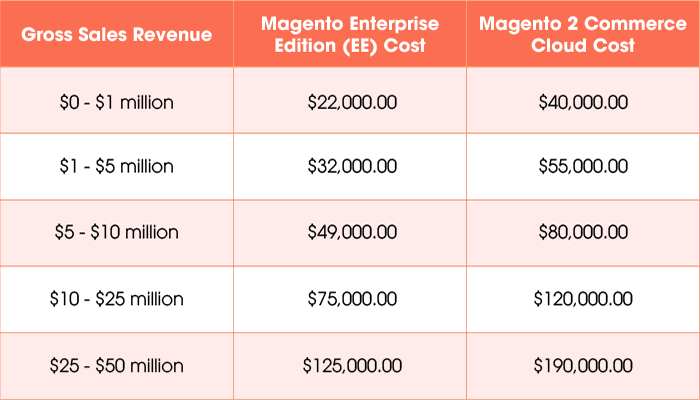
On the other hand, WooCommerce is a FREE plugin to download. However, WooCommerce offers fewer basic eCommerce features in comparison with the free option of Magento.
Additional Costs for Themes, Extensions, and Plugins
One thing in common is, that for both platforms, extensions and plugins to fulfill their default limitations tend to be expensive (some even require annual subscriptions). The cost of Magento extensions can vary widely, depending on the complexity and usefulness of the plugin. Some extensions might be free, while premium ones can range from $50 to several hundred dollars.
The cost of premium WooCommerce plugins is generally in the range of $30 to $200 or more. But you can also find many free plugins in the WordPress plugin repository. Another additional cost you should consider is the cost of themes.
Magento offers a range of free and premium themes available on the Magento Marketplace and other third-party theme marketplaces. The cost of premium themes can vary significantly, ranging from $50 to $500 or more, depending on the complexity and features of the theme.
WooCommerce, being a WordPress plugin, can use any WordPress theme. There are numerous free themes available in the official WordPress theme repository, and premium WooCommerce-specific themes can also be found on various marketplaces. The cost of premium WooCommerce themes is comparable to Magento, ranging from $50 to $200 or more.
Development and Maintenance Expenses
Even when you use the free edition of Magento, you still have to pay for imperial services like web hosting, domain name, and SSL certificate (estimated in Ecommerce Development Cost Breakdown). Not to mention, as Magento is a more complex platform, it might require a higher level of technical expertise for development and maintenance tasks. These costs usually are higher compared to other platforms.
WooCommerce, being a WordPress plugin, is relatively easier to set up and work with. WordPress is widely used and has a large community of developers, which can make finding affordable development/maintenance services easier. The development cost for WooCommerce is generally more budget-friendly compared to Magento, especially for smaller to medium-sized online stores.
There’s no doubt that WooCommerce is more affordable than Magento, but problems will arise when the number of your customers increases and your business scales. Accordingly, middle to large businesses are recommended to use Magento because of the great scalability of whatever edition you use. Or if you have had a clear growth and expansion target, here comes the same advice.
#2. User Experience and Design
Another important factor in the difference between Magento and WooCommerce is the user experience and design.
Interface and Ease of Use
Regarding friendliness for beginners, WooCommerce wins users’ hearts. The plugin adds basic eCommerce features to WP websites while retaining the ease of use of the parent platform. WooCommerce provides users with a straightforward user interface and pretty good customizability from the WordPress dashboard. For store owners having no experience in eCommerce, this point is a small plus.
In contrast, Magento users tend to be people who have at least basic technical knowledge. Amateur users might find it challenging to use the platform for customization, which involves coding skills. This will be a big problem if you handle technical things yourself. But if you are not a tech-minded person, it’s advisable to have a specialized technical team or get dedicated support from Magento agencies like BSS Commerce.
Responsive Design and Mobile-Friendliness
In recent versions, Magento has made efforts to improve its responsiveness and mobile-friendliness. However, out of the box, Magento might require some additional work to achieve full mobile optimization. It may depend on the theme or template you choose, and sometimes customizations may be needed to ensure a seamless user experience on various mobile devices.
While it is possible to create a mobile-friendly store with Magento, it may take more effort compared to some other platforms.
WooCommerce, being built on WordPress, benefits from the vast selection of responsive themes available in the WordPress ecosystem. Many WooCommerce themes are designed to be mobile-friendly from the start, offering a great user experience on smartphones and tablets without much extra effort. Additionally, WordPress’s responsive dashboard makes it easy to manage your online store even from mobile devices.
Customization Options and Design Flexibility
Magento is known for its extensive customization options and design flexibility. It offers a wide range of features and functionalities that cater to the needs of larger and more complex online stores. With Magento, you can create highly customized and unique designs to match your brand’s identity. However, the level of design flexibility might come with a steeper learning curve, and some advanced customization may require coding or professional assistance.
As the first Southeast Asian Magento partner with 11+ years of experience, BSS Commerce experts specialize in crafting attractive Magento stores that boost sales conversion rates. Over 150,000+ clients around the world have put their trust in our top-notch Magento 2 development service. Check out how the UK Bathroom Store doubled their sales conversion rate by 200% thanks to the collaboration with BSS Commerce.
WooCommerce also provides a decent level of customization and design flexibility, especially considering its integration with the WordPress ecosystem. You can choose from numerous WooCommerce-specific themes and thousands of general WordPress themes, giving you various design options. Additionally, there are plenty of plugins available to enhance your store’s design and functionality. WordPress’s block-based editor (Gutenberg) allows for easy page building and design changes, making it accessible to users without coding knowledge.
#3. Performance and Scalability
Analyzing Magento vs WooCommerce performance in handling high traffic, product volume, and growth potential assists businesses in making well-informed decisions for their online stores.
Magento vs WooCommerce Speed and Loading Times
Overall, both Magento vs WooCommerce are not light-speed platforms.
Compared with WooCommerce, Magento needs more server power to run properly. Since your hosting server location can affect loading time, the platform requires a dedicated server, which can be a little heavy on your budget. However, we can not forget that Magento can easily handle a larger number of products than WooCommerce.
On average, the Magento pages that compose a classic user’s sales funnel waste 665 milliseconds to load, which exceeds the “under 500 milliseconds” goal set by Google.
When it comes to using WooCommerce, a stand-alone plugin obviously cannot improve WordPress websites’ performance unless you install additional plugins that can enhance the speed and other performance-related parameters.
Here comes the downside that might significantly affect performance: Since WooCommerce features are limited, WP-based online stores usually need more additional plugins to fulfill business needs, which will slow down the speed. The average loading time of all monitored WooCommerce stores reached 776 milliseconds.
Whether you choose Magento or WooCommerce, your website performance also depends so much on
- Hosting provider
- Size of the application and number of functionalities
- Image size
Handling Large Catalogs and High-Traffic
Magento is a robust eCommerce platform, so scalability is not outside of its reach. The truth is that this platform can host hundreds of thousands of products at once. With Magento 2, you can count on Varnish Cache – the leading caching tool that allows you to expand your online store without sacrificing its performance. The addition of new features or algorithms will not affect your website’s speed.
WooCommerce offers the same scalability compared with Magento. It is a matter of if your WordPress hosting resources can handle it. Usually, users are offered a variety of solutions from hosting providers, including getting a dedicated server. There are also Managed WordPress options from providers like SiteGround, and WP Engine.
Database Management and Optimization
Magento
Magento is built to handle larger and more complex eCommerce websites, which means it generally requires a more robust and scalable database structure. It uses the EAV (Entity-Attribute-Value) model, which provides flexibility for handling a wide range of product attributes and categories. While this allows for a high level of customization, it can also lead to a more complex database schema.
However, Magento can be more demanding in terms of database resources. As the database grows with more products, orders, and customer data, it may require regular optimization to maintain performance. Proper indexing, caching, and database maintenance are essential to ensure smooth and efficient operation. Magento provides tools and options for database optimization, but it might require technical knowledge to implement them effectively.
Woocommerce
WooCommerce, being a WordPress plugin, follows a more straightforward and traditional relational database model.
It uses a combination of custom post types and custom taxonomies to manage products, orders, and other eCommerce data. The database structure in WooCommerce is generally less complex compared to Magento, making it more accessible for users who are familiar with standard relational databases.
WooCommerce’s database optimization is straightforward, especially for smaller to medium-sized stores. Since WooCommerce relies on WordPress, it benefits from various plugins and tools that can help optimize database performance.
WordPress itself is known for its relatively efficient database management. However, for larger stores with significant amounts of data, WooCommerce may also benefit from regular optimization practices such as indexing and caching.
#4. Integration and Compatibility
This is an overview of how Magento ECommerce vs WooCommerce integrates with third-party tools and extensions, and their compatibility with various systems to enhance functionality and streamline business operations.
Third-Party Integrations and Extensions
An e-commerce platform itself has limitations. This is where extensions come to fulfill advanced and custom business needs. Fortunately, users of both e-commerce platforms can access thousands of extensions/plugins to extend functionalities on their websites. Both Magento and WooCommerce cater to all issues through third-party plugins.
While the Enterprise plan integrates many premium functionalities, Community edition users can be assured when purchasing extensions from Magento Marketplace for out-of-the-box features. This is a huge store of more than 3.600 free and premium Magento extensions. Each one has to pass a strict review process by Magento’s QA team in technical and content aspects before it is officially listed on the marketplace.
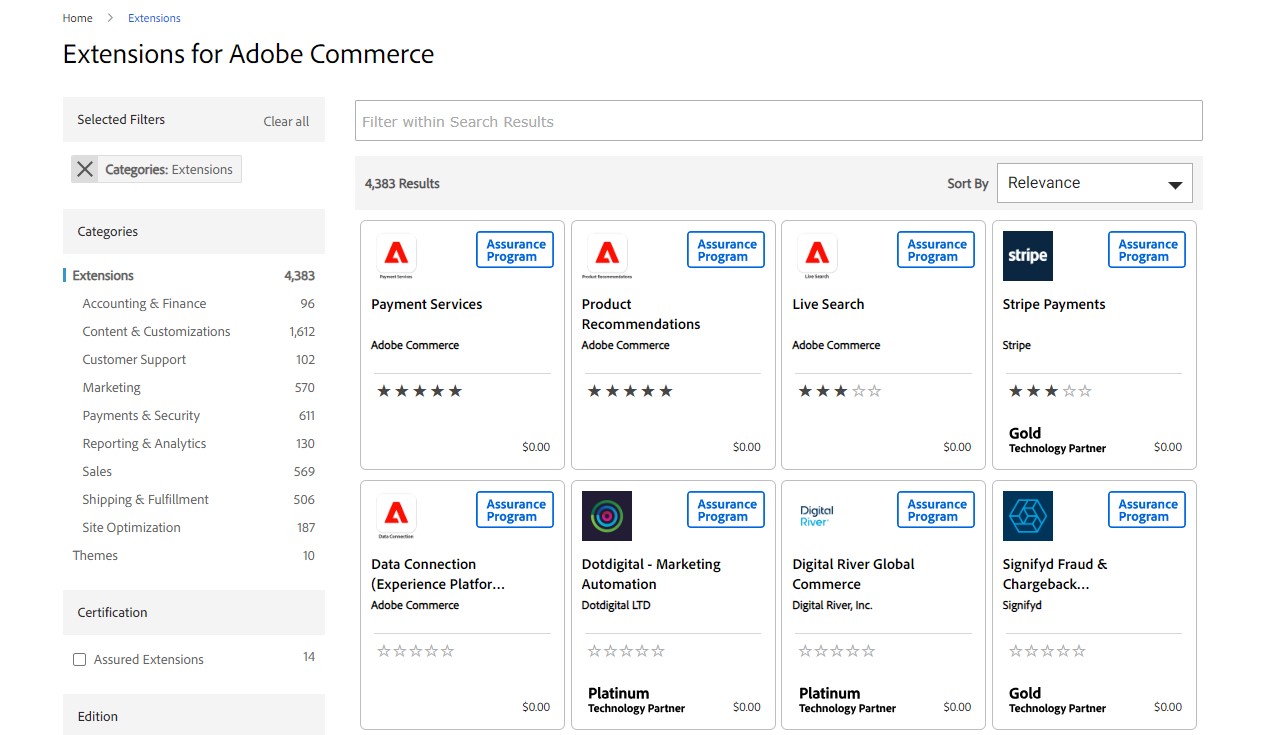
In addition, Magento 2 is compatible with a vast number of 3rd-party statistical tools like Google Analytics, New Relic, MixPanel, etc. It is the most powerful eCommerce platform in terms of discovering future trends and providing valuable insights for scaling both up and down.
Likewise, WooCommerce also has an extension store that gathers hundreds of plugins across all your logistical, technical, and marketing needs. It also allows you to integrate with 3rd service through APIs.
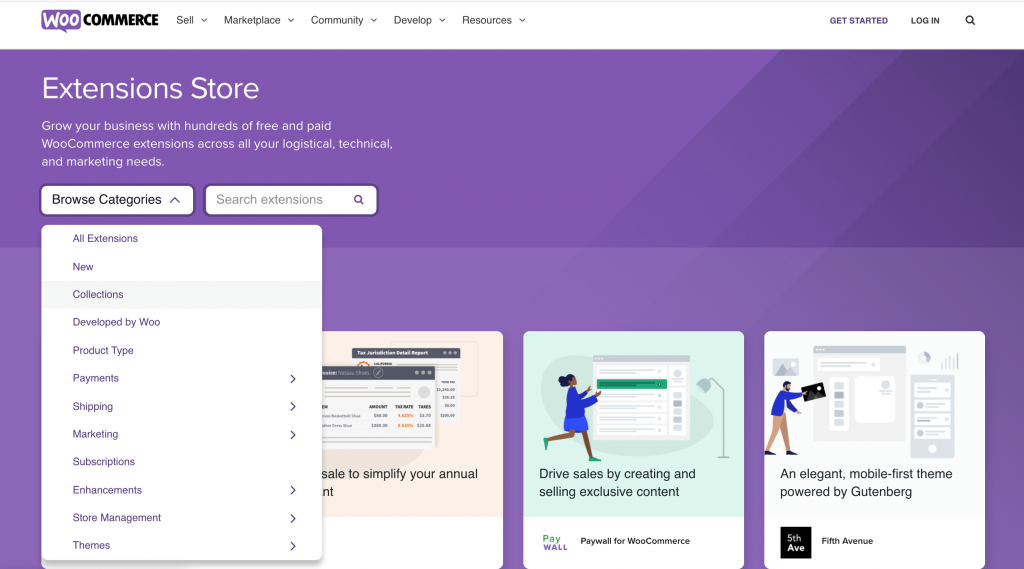
Compatibility With Various Payment Gateways
Magento offers integrations with a wide range of popular payment providers, including PayPal, Stripe, Authorize.Net, Braintree, and more. Additionally, Magento’s modular architecture allows for easy integration of custom or less common payment gateways through extensions. This flexibility makes it suitable for eCommerce businesses operating in different countries with diverse payment preferences.
WooCommerce also offers a vast selection of payment gateway integrations, leveraging the broad WordPress ecosystem. It supports many popular payment processors like PayPal, Stripe, Square, and more. However, the number of available payment gateways might not be as extensive as Magento’s, especially for niche or less common options.
Cross-Platform Functionality
For cross-platform functionality, businesses using Magento may need to rely on additional third-party tools or custom development to connect with other systems, such as ERP or CRM.
WooCommerce operates as a WordPress plugin, allowing seamless integration with a wide variety of WordPress plugins and themes. This inherent cross-platform compatibility empowers businesses to extend their online stores beyond e-commerce functionality.
WordPress’s flexibility enables integration with various third-party services, content marketing tools, and other platforms, making it a versatile option for businesses seeking to create a more holistic online presence.
#5. Support and Community
The robust support and active user communities are other factors to consider between Magento vs WooCommerce, as they provide invaluable assistance, troubleshooting, and fostering growth for businesses.
Official Support Channels
Magento support significantly differs between editions. Magento Community users can only consult and seek help from official documentation and communities. On the other hand, businesses using Magento Enterprise are offered official full-fledged support via email or live support.
WooCommerce provides support services through their Helpdesk – this can be live chat or email-based support.
Availability of Documentation and Resources
Magento offers many additional resources for support, such as Magento Help Center, Magento DevDocs, Magento Forums, or technical blogs written by certified Magento partners like BSS Commerce Confluence.
WooCommerce offers FAQ documentation, which contains answers to Frequently Asked Questions related to WooCommerce, products sold on WooCommerce.com, and account management on WooCommerce.com.
Community Forums and User Communities
Both Magento and WooCommerce have a vast community of users worldwide to support store owners when they run into problems.
Choosing the Right Platform for Your Business
After a long comparison of WooCommerce vs Magento 2, we want you to keep in mind that when selecting an eCommerce platform for your business, there are 4 crucial factors to consider, including:
Assessing Your Business Requirements and Goals
Start by understanding your business’s unique requirements and long-term goals. Consider factors such as the size of your product catalog, the complexity of your offerings, and the target market. Assessing these aspects will help you identify the essential features and functionalities you need in an eCommerce platform.
Consideration of Budget and Resources
Your budget plays a critical role in selecting the right platform. Determine the amount you are willing to invest in the initial setup, as well as ongoing maintenance and future enhancements. Additionally, assess the resources available in terms of staff expertise and time commitment for managing the platform.
Analyzing Scalability and Growth Potential
Your eCommerce platform should have the ability to grow with your business. Consider the scalability of the platform in terms of handling increased website traffic, product additions, and customer data. Choosing a flexible and scalable platform ensures that your online store can adapt to the evolving needs of your business.
Evaluating Technical Expertise and Support Needs
Assess the technical expertise within your team or organization. Some platforms require more advanced technical knowledge for setup and customization. Consider whether you will need additional support, such as developer resources or official technical support channels, to address any issues that may arise.
Along with WooCommerce, other alternatives to Magento platform could be suitable with your business model. Let’s read on these articles:
Summary: Which Is Better Magento or Woocommerce
In a nutshell, both Magento vs WooCommerce have their own perk, but their target users might differ. Before building your store with one of these two platforms, you need to define what type of user base you are.
Magento is a robust platform usually used by medium to large-scale businesses. The excellent scalability makes it ideal for large sites with a huge inventory and visits. In case premium functionalities are not necessary for your needs, the free edition is a good option. If you are preparing for a Magento web store, it’s advisable to find support from experienced Magento development agencies. BSS Commerce is an instance where you can reach out for consultation.
In contrast, WooCommerce is a simpler platform for those who are already familiar with WordPress. The solution best suits small businesses that need a medium level of scalability, functionality, security, and so on.
